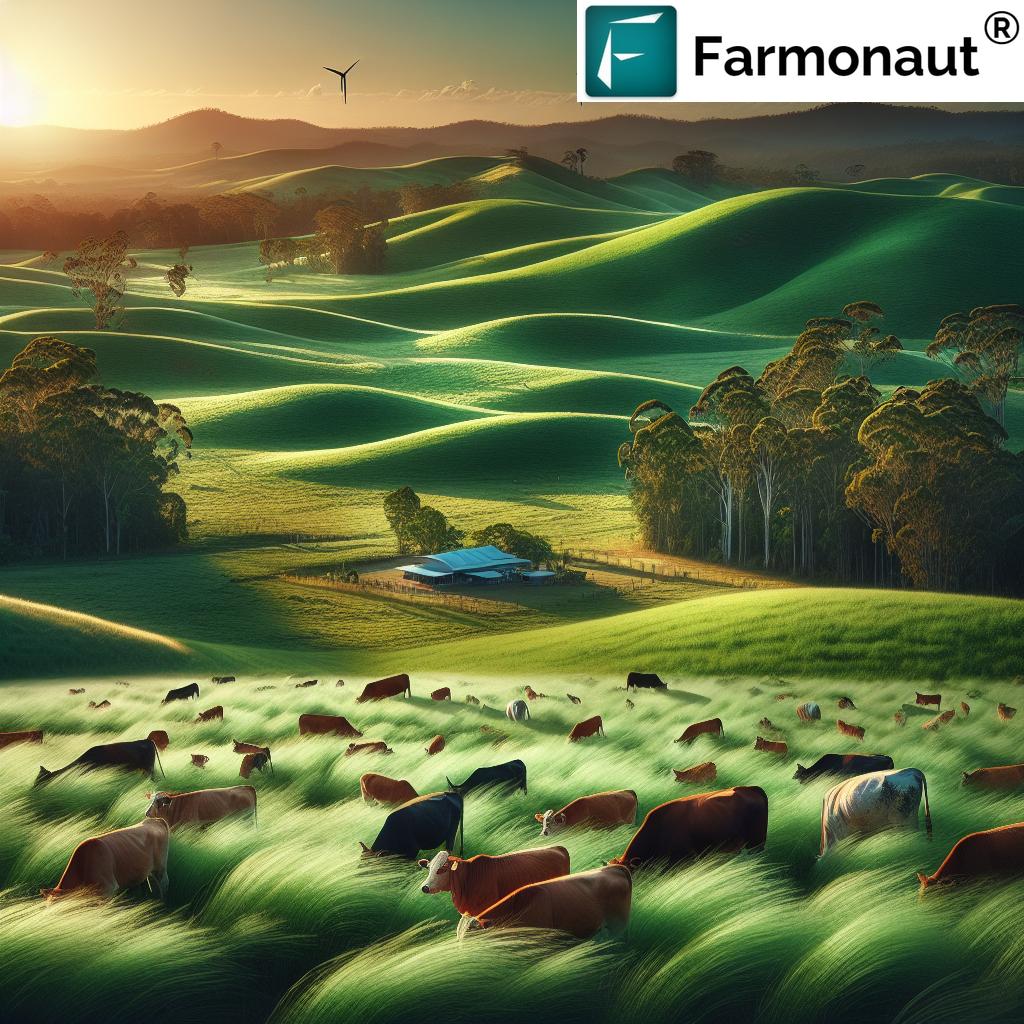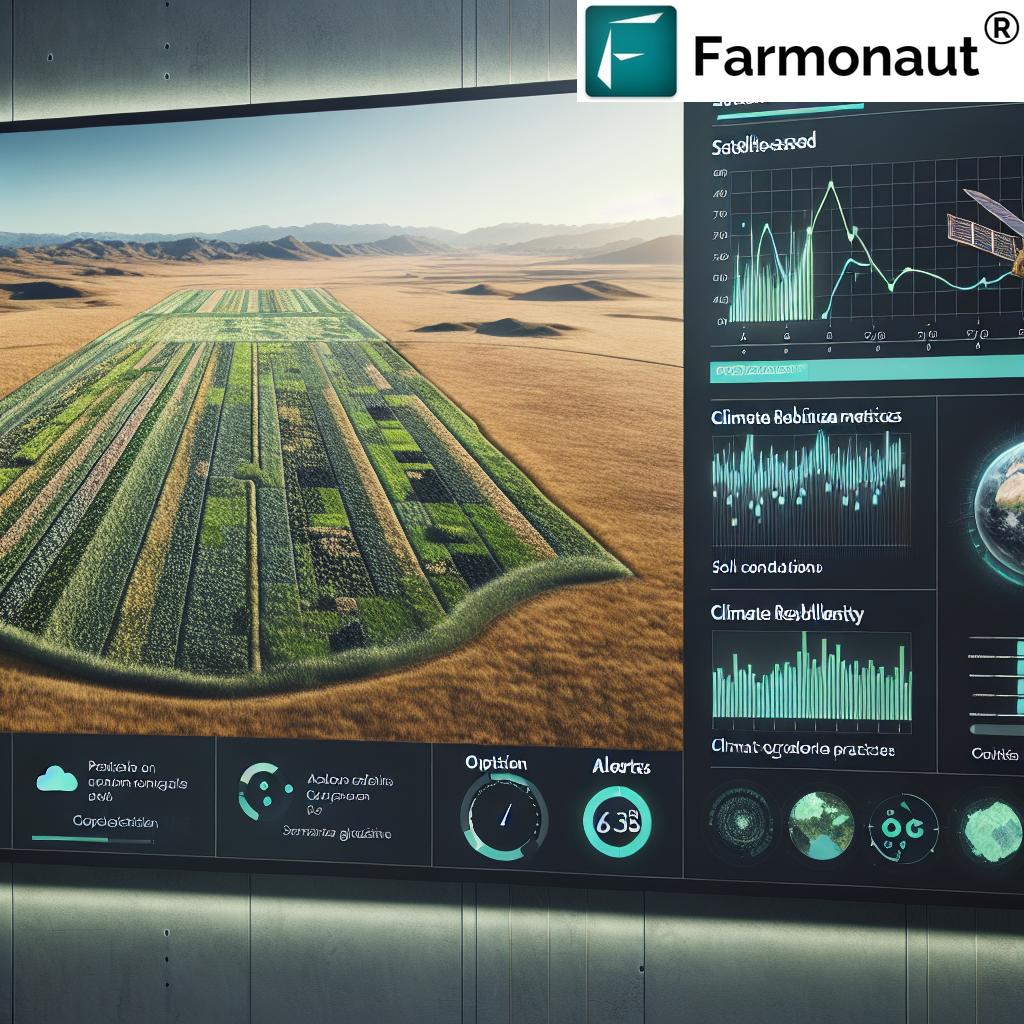Sustainable Pasture Management: Farmonaut’s Guide to Buffel Grass Benefits for Queensland Graziers
“Buffel grass’s deep root system can prevent soil erosion in up to 90% of Queensland’s grazing lands.”
In the heart of Queensland’s vast agricultural landscape, a debate is brewing that has caught the attention of graziers, environmentalists, and policymakers alike. At the center of this discourse is buffel grass, a drought-resistant species that has become both a boon and a bane for the region’s pastoral communities. As representatives of Farmonaut, we’re here to shed light on this complex issue and provide a comprehensive guide to sustainable pasture management, with a focus on the benefits of buffel grass for Queensland graziers.

Understanding Buffel Grass: A Controversial Yet Vital Resource
Buffel grass (Cenchrus ciliaris) has been a cornerstone of Queensland’s grazing industry for decades. This hardy plant, introduced to Australia in the 1930s, has since become an integral part of the region’s pastoral ecosystem. However, its rapid spread and dominant nature have led to it being considered for listing as a Weed of National Significance (WoNS). This potential classification has sparked a heated debate among various stakeholders in the agricultural sector.
At Farmonaut, we recognize the importance of balanced and informed decision-making when it comes to pasture management. Our satellite-based crop monitoring technology offers invaluable insights that can help graziers make the most of buffel grass while mitigating potential risks. Let’s delve deeper into the benefits and challenges associated with this contentious yet crucial grass species.
The Benefits of Buffel Grass for Queensland Graziers
- Drought Resistance: One of the most significant advantages of buffel grass is its exceptional ability to withstand prolonged periods of drought. Its deep root system allows it to access water and nutrients from far below the soil surface, making it a resilient choice for Queensland’s often harsh and unpredictable climate.
- Soil Erosion Prevention: The extensive root network of buffel grass plays a crucial role in binding soil particles together, significantly reducing the risk of erosion. This is particularly important in areas prone to wind and water erosion, helping to maintain the integrity of the land.
- Rapid Recovery Post-Fire: In a region where bushfires are a constant threat, buffel grass’s ability to quickly regenerate after fire events is invaluable. This characteristic ensures that pastures can recover rapidly, providing vital feed for livestock during critical recovery periods.
- Livestock Feed Resource: Buffel grass is highly palatable to livestock and provides a reliable source of nutrition. Its ability to produce substantial biomass even under challenging conditions makes it a crucial feed resource for graziers, especially during times of drought.
- Climate Resilience: As climate change continues to impact agricultural practices worldwide, the adaptability of buffel grass to varying conditions positions it as a key player in climate-resilient agriculture.
To better understand how these benefits translate into practical advantages for Queensland graziers, let’s take a look at a comprehensive comparison table:
| Benefit | Description | Management Strategy |
|---|---|---|
| Drought Resistance | Can survive extended dry periods, maintaining pasture cover | Implement rotational grazing to maintain plant vigor; monitor with Farmonaut’s satellite technology |
| Soil Erosion Prevention | Deep roots bind soil, reducing erosion by up to 80% | Maintain adequate ground cover; use Farmonaut’s NDVI data to assess vegetation health |
| Quick Recovery Post-Fire | Regrows rapidly after fires, providing feed within weeks | Develop fire management plans; use Farmonaut’s monitoring to track recovery |
| Livestock Feed Resource | High palatability and nutrition, increasing carrying capacity by up to 30% | Implement strategic grazing; use Farmonaut’s biomass estimation for feed budgeting |
| Climate Resilience | Adaptable to changing climate conditions | Diversify pasture species; use Farmonaut’s climate data for long-term planning |
As we can see, the benefits of buffel grass are numerous and significant for Queensland’s graziers. However, it’s crucial to approach its management with a balanced perspective, considering both its advantages and potential drawbacks.
The Controversy Surrounding Buffel Grass
Despite its many benefits, buffel grass has not been without controversy. The main concerns raised by environmentalists and some policymakers include:
- Invasive Nature: Buffel grass can spread rapidly, potentially outcompeting native species and altering ecosystems.
- Fire Risk: Its high biomass production can increase fuel loads, potentially leading to more intense bushfires.
- Biodiversity Impact: There are concerns about its effect on native flora and fauna, particularly in areas where it has become dominant.
These concerns have led to the consideration of listing buffel grass as a Weed of National Significance (WoNS). However, rural advocacy organizations and many graziers argue that the benefits of buffel grass far outweigh its potential drawbacks, especially when managed properly.
Farmonaut’s Role in Sustainable Buffel Grass Management
At Farmonaut, we believe that technology can play a crucial role in balancing the benefits of buffel grass with environmental concerns. Our satellite-based crop monitoring system offers several tools that can aid in the effective management of buffel grass pastures:
- Vegetation Health Monitoring: Our NDVI (Normalized Difference Vegetation Index) analysis allows graziers to track the health and density of buffel grass pastures in real-time. This information is crucial for making informed decisions about grazing intensity and rotation.
- Soil Moisture Analysis: By providing accurate soil moisture data, we help graziers optimize their water management strategies, ensuring that buffel grass pastures remain productive even during dry spells.
- Fire Risk Assessment: Our technology can help identify areas of high biomass accumulation, allowing for targeted management to reduce fire risks associated with buffel grass.
- Pasture Productivity Tracking: By analyzing historical and current data, we can help graziers maximize the productivity of their buffel grass pastures while minimizing environmental impact.
Explore Farmonaut’s satellite-based solutions:
“Proper management of buffel grass can increase livestock feed resources by up to 40% during drought periods.”
Best Practices for Sustainable Buffel Grass Management
To harness the benefits of buffel grass while mitigating its potential negative impacts, Queensland graziers can implement the following best practices:
- Rotational Grazing: Implement a well-planned rotational grazing system to prevent overgrazing and maintain plant vigor. Farmonaut’s vegetation health monitoring can guide these decisions.
- Biodiversity Conservation: Maintain areas of native vegetation alongside buffel grass pastures to support local biodiversity. Our satellite imagery can help identify and monitor these conservation areas.
- Fire Management: Develop and implement fire management plans that consider the high biomass production of buffel grass. Use Farmonaut’s fire risk assessment tools to identify high-risk areas.
- Soil Health Monitoring: Regularly assess soil health to ensure that buffel grass is not depleting soil nutrients. Our soil moisture analysis can complement on-ground testing.
- Weed Control: While buffel grass itself is considered a weed by some, it’s important to manage other invasive species within buffel grass pastures. Farmonaut’s vegetation mapping can help identify areas where weed control is needed.
The Economic Importance of Buffel Grass for Queensland
The debate surrounding buffel grass extends beyond environmental concerns to encompass its significant economic impact on Queensland’s rural communities. As a vital feed resource for livestock, buffel grass plays a crucial role in supporting the region’s beef industry, one of the state’s largest agricultural sectors.
- Livestock Production: Buffel grass pastures have significantly increased the carrying capacity of many Queensland grazing properties, allowing for higher stocking rates and improved livestock production.
- Drought Resilience: The ability of buffel grass to provide feed during dry periods has helped many graziers weather severe droughts, reducing the economic impact of these events on rural communities.
- Land Value: Properties with well-established buffel grass pastures often command higher values due to their increased productivity and drought resilience.
- Rural Employment: The improved productivity of buffel grass pastures supports employment in rural areas, from farm workers to associated industries such as transport and processing.
Given these economic factors, any decisions regarding the management or potential regulation of buffel grass must carefully consider the broader impact on Queensland’s rural economies and the livelihoods of graziers and regional communities.
Farmonaut’s Contribution to Sustainable Agriculture
At Farmonaut, we’re committed to supporting sustainable agricultural practices through innovative technology. Our satellite-based solutions offer valuable tools for graziers looking to optimize their buffel grass management:
- Precision Agriculture: Our high-resolution satellite imagery allows for precise monitoring of pasture conditions, enabling graziers to make data-driven decisions about grazing management, fertilization, and weed control.
- Climate Resilience: By providing accurate weather forecasts and historical climate data, we help graziers plan for and adapt to changing climate conditions, ensuring the long-term sustainability of their buffel grass pastures.
- Resource Optimization: Our soil moisture analysis and vegetation health monitoring tools help graziers optimize their use of water and other resources, promoting more sustainable and efficient farming practices.
Explore our API for custom integrations: Farmonaut API
For developers, check out our comprehensive documentation: API Developer Docs
The Future of Buffel Grass in Queensland
As the debate surrounding buffel grass continues, it’s clear that a balanced approach is needed to address both the benefits and concerns associated with this species. The future management of buffel grass in Queensland will likely involve:
- Targeted Management: Rather than broad-scale eradication or unrestricted spread, a targeted management approach that considers local conditions and needs may be the most effective strategy.
- Research and Innovation: Continued research into buffel grass management techniques and the development of innovative technologies, like those offered by Farmonaut, will play a crucial role in optimizing its use while minimizing negative impacts.
- Policy Development: Policymakers will need to work closely with graziers, environmental groups, and rural communities to develop policies that balance agricultural productivity with environmental conservation.
- Education and Outreach: Increasing awareness and understanding of both the benefits and potential risks of buffel grass will be crucial for informed decision-making at all levels.
Conclusion: Embracing Sustainable Pasture Management
The debate surrounding buffel grass in Queensland highlights the complex challenges facing modern agriculture. As we strive to balance productivity with environmental sustainability, tools like Farmonaut’s satellite-based monitoring systems become increasingly valuable.
By embracing sustainable pasture management practices and leveraging cutting-edge technology, Queensland graziers can maximize the benefits of buffel grass while mitigating its potential drawbacks. This approach not only supports the economic viability of rural communities but also contributes to the long-term health of the region’s unique ecosystems.
As we move forward, collaboration between graziers, researchers, policymakers, and technology providers will be key to developing holistic solutions that ensure the sustainable use of buffel grass and other pastoral resources. At Farmonaut, we’re committed to being a part of this solution, providing the tools and insights needed to support sustainable, productive, and resilient agricultural practices in Queensland and beyond.
FAQ: Buffel Grass and Sustainable Pasture Management
Q1: What is buffel grass, and why is it important for Queensland graziers?
A1: Buffel grass (Cenchrus ciliaris) is a drought-resistant grass species that has become a vital feed resource for livestock in Queensland. It’s important due to its ability to withstand harsh conditions, prevent soil erosion, and provide reliable forage for cattle.
Q2: Why is buffel grass considered controversial?
A2: While beneficial for grazing, buffel grass is considered invasive in some contexts. It can outcompete native species and potentially increase fire intensity due to its high biomass production. This has led to discussions about listing it as a Weed of National Significance (WoNS).
Q3: How can Farmonaut’s technology help in managing buffel grass pastures?
A3: Farmonaut’s satellite-based monitoring provides real-time data on vegetation health, soil moisture, and pasture productivity. This information helps graziers make informed decisions about grazing intensity, water management, and fire risk mitigation.
Q4: What are some best practices for sustainable buffel grass management?
A4: Key practices include implementing rotational grazing, maintaining biodiversity through conservation areas, developing fire management plans, monitoring soil health, and controlling other invasive species within buffel grass pastures.
Q5: How does buffel grass contribute to climate-resilient agriculture?
A5: Buffel grass’s deep root system and drought tolerance make it resilient to climate variability. It can provide feed during dry periods and recover quickly after fires, contributing to the overall resilience of grazing systems in changing climate conditions.

Explore Farmonaut’s Subscription Options
By leveraging Farmonaut’s advanced satellite technology and data-driven insights, Queensland graziers can optimize their buffel grass management strategies, ensuring sustainable and productive pastures for years to come. Our commitment to innovation and sustainable agriculture aligns perfectly with the needs of modern graziers facing complex environmental and economic challenges.
















